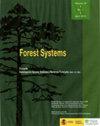低密度下两个杨树×canadensis无性系‘I-214’和‘I-488’的耗水量和初步作物系数
IF 0.7
4区 农林科学
Q3 FORESTRY
引用次数: 1
摘要
研究目的:在气候变化情景下,地中海地区杨树人工林的生产力可能会因降水减少而降低。因此,了解这些人工林的用水量对其管理至关重要。本研究的目的是估计两个普遍使用的杨树无性系(加拿大杨树' I-214 '和' I-488 ')的耗水量和初步作物系数(kc)。研究区域:智利中部(36º05 'LS;南纬72度47分;470年m.a.s.l)。材料与方法:在2016-2017年生长季,以2009年和2010年建立的杨树无性系低密度商业林分(6×6 m)为试验材料。在每个群落中,通过使用微型溶渗仪测定蒸发和利用树液流测定蒸腾来测量水分平衡。此外,还测量了水分状况和叶面积指数(LAI),以了解两个无性系的行为。主要结果:虽然两个无性系供水量相同,但在蒸散量(ETr)和水汽压亏缺(VPD)较高的时段,I-488的蒸腾量(T)高于I-214。另一方面,植物水分状况也存在差异,与I-214相比,' I-488 '具有更多的负回传水势(Ψx)。反过来,I-214的叶面积指数(LAI)高于I-488,并且在季节中生长更多,反驳了其更高的效率。研究重点:这些结果可以表征地中海气候条件下两个克隆的水行为,但有必要将研究扩展到更多的季节和不同的年龄范围。关键词:作物系数;水的消耗;水平衡;杨树。本文章由计算机程序翻译,如有差异,请以英文原文为准。
Water consumption and preliminary crop coefficients of two Populus ×canadensis clones (‘I-214’ and ‘I-488’) grown at low planting density
Aim of study: The productivity of poplar plantations in Mediterranean climates might be reduced due to lower precipitations in a climate change scenario. Therefore, understanding the water consumption in these plantations is essential for their management. The objective of this study was to estimate water consumption and preliminary crop coefficients (kc) of two universally used poplar clones (Populus x Canadensis ‘I-214’ and ‘I-488’).Area of study: Central Chile (36º 05 'LS; 72º 47' LW; 470 m.a.s.l.).Materials and methods: Commercial stands of poplar clones established in 2009 and 2010 at low density (6×6 m) were used to experiment during the 2016-2017 growing season. In each of them, water balance was measuring, by determining evaporation using micro lysimeters and transpiration using the sap flow. Additionally, the water status and the leaf area index (LAI) were measured to understand the behaviour of both clones.Main results: Although the water supplied to both clones was the same, the transpiration (T) was higher for ‘I-488’ than ‘I-214’, at those moments in which the evapotranspiration (ETr) and the vapour pressure deficit (VPD) was higher. On the other hand, differences were observed in plant water status, ‘I-488’ had more negative xilematic water potential (Ψx) compared to ‘I-214’. In turn, I-214 proved to have a higher Leaf Area Index (LAI) than I-488 and grew more during the season, refuting its greater efficiency.Research highlights: These results allow characterizing the water behaviour of both clones in Mediterranean climate condition, but it is necessary to extend the study to more seasons and different age ranges.Keywords: Crop coefficient; water consumption; water balance; poplar.
求助全文
通过发布文献求助,成功后即可免费获取论文全文。
去求助
来源期刊

Forest Systems
FORESTRY-
CiteScore
1.40
自引率
14.30%
发文量
30
审稿时长
6-12 weeks
期刊介绍:
Forest Systems is an international peer-reviewed journal. The main aim of Forest Systems is to integrate multidisciplinary research with forest management in complex systems with different social and ecological background
 求助内容:
求助内容: 应助结果提醒方式:
应助结果提醒方式:


